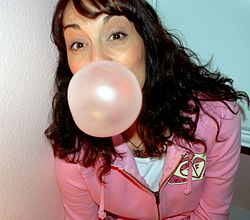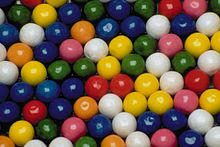 A woman blowing a bubble with bubble gum. | |
| Origin | |
|---|---|
| Creator(s) | Walter E. Diemer |
| Type | Chewing gum |
Bubble gum is a type of chewing gum, designed to be inflated out of the mouth as a bubble.
History
In 1928, Walter E. Diemer, an the accountant for the Fleer Chewing Gum Company in Philadelphia, was experimenting with new gum recipes. One recipe was found to be less sticky than regular chewing gum, and stretched more easily. This gum became highly successful and was eventually named by the president of Fleer as Dubble Bubble. The original bubble gum was pink because that was the only dye Diemer had on hand at the time and it was his favorite color.
To test his recipe, Diemer took samples of the new gum to a local store where it sold out in a single day. To help sell the new Dubble Bubble gum, Diemer taught salespeople how to blow bubbles so that they could teach potential customers. Dubble Bubble remained the only bubble gum on the market until Bazooka entered after World War II.[citation needed]
In modern chewing gum, if natural rubber such as chicle is used, it must pass several purity and cleanliness tests. However, most modern types of chewing gum use synthetic gum based materials. These materials allow for longer-lasting flavour, a better texture, and a reduction in tackiness.[1]
Flavors
Bubble gum is available in many colors and flavors. A "bubblegum flavor" is the taste of the unflavored gum, made from chemicals such as ethyl methylphenylglycidate, isoamyl acetate, fruit extracts and others, although the exact ingredients were kept a mystery to customers.[citation needed] When blended, the chemicals and extracts fuse to make a sweet, palatable flavor. Gums made with vanilla, coconut, peppermint and almond extracts are available.
Flavors include blue raspberry, lemon, strawberry, apple, cherry, watermelon, cinnamon, banana, peppermint, cotton candy and grape of which strawberry and banana can be achieved with ethyl methylphenylglycidate and isoamyl acetate limonene, respectively. Malic acid can be used for apple flavor, allyl hexanoate for pineapple, ethyl propionate for fruit punch, cinnamic aldehyde for cinnamon and acetophenone for cherry. More unusual flavors such as berry, cola, lemon lime, peach, tropical fruit, pineapple, orange fruit punch can also be found, as well as novelty tastes such as bacon or popcorn.
In taste tests, children tend to prefer strawberry and blue raspberry flavors, rejecting more complex flavors as they say these make them want to swallow the gum rather than continue chewing.[2]
Records
The 23-inch bubble blown by Susan Montgomery Williams of Fresno, California in 1996 holds the Guinness World Record for largest bubblegum bubble. Chad Fell holds the record for "Largest Hands-free Bubblegum Bubble" at 50.8 centimetres (20.0 in), achieved on 24 April 2004.[3]
See also
- Blibber-Blubber
- Functional gum
- Gum base
- Gum industry
- Inca Kola
- List of chewing gum brands
References
- ^ "TLC Cooking "What is chewing gum made of?"". Recipes.howstuffworks.com. 2000-04-01. Retrieved 2012-11-15.
- ^ McGrath, Susan. "Stuck On Bubble Gum". National Geographic World 277. Readers' Guide Full Text Mega (H.W. Wilson).
- ^ "Largest Bubblegum Bubble Blown". Guinness Book of World Records. Retrieved 2 November 2011.
